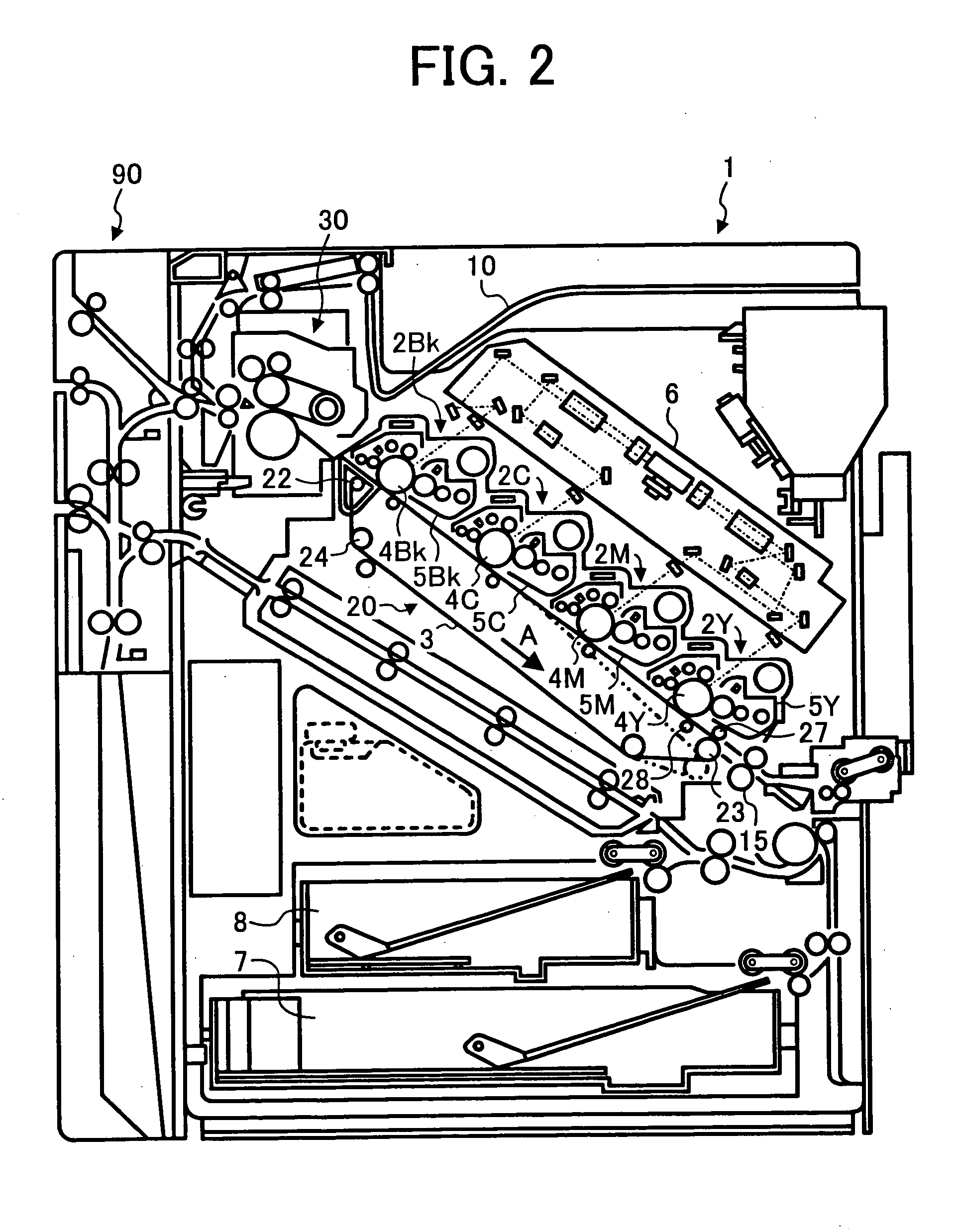Fixing device, image forming apparatus using the same and process cartridge
a technology of fixing device and image forming apparatus, which is applied in the direction of electrographic process apparatus, instruments, optics, etc., can solve the problems of triboelectric charging of fixing members, contamination of transfer materials, and friction between both members, so as to reduce the occurrence of contamination
- Summary
- Abstract
- Description
- Claims
- Application Information
AI Technical Summary
Benefits of technology
Problems solved by technology
Method used
Image
Examples
example 1
(Toner 1)
(Manufacturing Example of Polyesters for Addition)
The following components were contained in a reaction container having a condenser, a stirrer and a nitrogen introducing tube and polyadded for 10 hours at 210° C. under normal pressure.
Adduct of bisphenol A with 2 moles of ethylene oxide690Terephthalic acid230
Then the reaction was further continued for 5 hours under a reduced pressure of from 10 to 15 mmHg. Subsequent to cooling down to 160° C., 18 parts of phthalic anhydride were added thereto to perform a reaction for 2 hours. Thus, unmodified polyester (a) having a weight average molecular weight Mw of 85,000 was prepared.
(Manufacturing Example of Prepolymer)
The following components were contained in a reaction container having a condenser, a stirrer and a nitrogen introducing tube and reacted for 8 hours at 230° C. under normal pressure.
Adduct of bisphenol A with 2 moles of ethylene oxide800Isophthalic acid160Terephthalic acid60Dibutyl tin oxide2
Then the ...
example 2
(Toner 2)
(Preparation of Magenta Master Batch Particle)
The following components were stirred by a flusher.
Water600Pigment Red 57 wet cake (50% solid portion)200
Then, after 1,200 parts of a polyester resin having an acid value of 3 mgKOH / g, a hydroxyl value of 25 mgKOH / g, a number average molecule weight Mn of 3,500, a ratio (Mw / Mn) of a weight average molecular weight Mw to the number average molecular weight of 4.0, and a glass transition temperature (Tg) of 60° C. were added to the mixture, the mixture was kneaded for 30 minutes at 150° C. Further, 1,000 parts of xylene were added thereto and the mixture was kneaded for one hour. Subsequent to removal of water and xylene, the resultant was roll-cooled and pulverized and subject to 3 roll milling twice. Consequently, a magenta color master batch colorant MB1-M having an average particle diameter of about 0.2 μm was obtained.
(Manufacturing Example of a Prepolymer)
The following components were contained in a reaction cont...
example 3
(Toner 3)
(Manufacturing Example of a Prepolymer)
The following components were contained in a reaction container having a condenser, stirrer and a nitrogen introducing tube and reacted for 8 hours at 220° C. under normal pressure.
Adduct of bisphenol A with 2 moles of ethylene oxide755Isophthalic acid195Terephthalic acid15Dibutyl tin oxide4
Then the reaction was further continued for 5 hours under a reduced pressure of from 50 to 100 mmHg while dehydrating. Subsequent to cooling down to 160° C., 10 parts of phthalic anhydride were added thereto to perform a reaction for 2 hours. Subsequent to further cooling down to 80° C., 170 parts of isophorone diisocyanate were added thereto in ethyl acetate to react for another 2 hours. Consequently, a prepolymer (3) having a weight average molecular weight of 25,000 containing an isocyanate group was prepared.
(Manufacturing Example of the Toner)
The following components were set in a beaker and stirred and dissolved.
Prepolymer (3)15....
PUM
 Login to View More
Login to View More Abstract
Description
Claims
Application Information
 Login to View More
Login to View More - R&D
- Intellectual Property
- Life Sciences
- Materials
- Tech Scout
- Unparalleled Data Quality
- Higher Quality Content
- 60% Fewer Hallucinations
Browse by: Latest US Patents, China's latest patents, Technical Efficacy Thesaurus, Application Domain, Technology Topic, Popular Technical Reports.
© 2025 PatSnap. All rights reserved.Legal|Privacy policy|Modern Slavery Act Transparency Statement|Sitemap|About US| Contact US: help@patsnap.com



